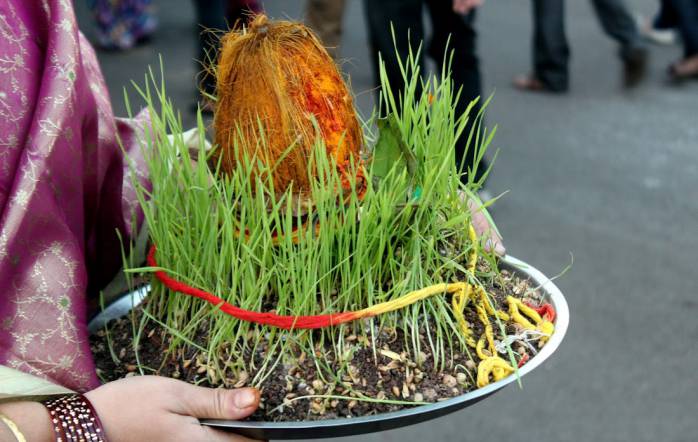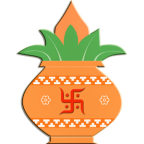No products in the cart.
Ghatasthapana is observed on the first day of Navratri – Pratipada day and is continued for the next nine days. The puja ends on the 10th day morning of Vijaya Dasami or Dasara.
Ghatasthapana Puja Items
- Wide and open Clay Pot to sow Sapta Dhanya
- Clean Soil to sow Sapta Dhanya
- Sapta Dhanya or seeds of seven different grains
- Small clay or brass Pitcher
- Sacred water to fill the Kalash or Ganga Jal
- Sacred thread / Moli / Kalaya
- Scent (perfume)
- Supari (betel nuts)
- Coins to put into the Kalash
- 5 leaves of Ashoka or Mango tree
- A Lid to cover the Kalash
- Raw Rice or unbroken rice known as Akshat (अक्षत) to put in the lid
- Unpeeled Coconut
- Red Cloth to warp coconut
- Flowers and Garland preferably marigold
- Durva grass
Ghatasthapana Puja Vidhi
- Clean the puja room or area where you plan to perform the Ghatsthapana.
- Take a pitcher with large mouth made of mud or copper and fill it with soil and sow seven types of grains like barely, wheat etc. Nowadays people opt for single grain or lentil or gram. While sowing the grains mantras dedicated to Lord Varuna are chanted. If you do not know any Vedic mantras, you can use any mantra you know especially dedicated to Goddess Shakti.
- Bring another set of soil and make a thick square or rectangle bed with thickness of five or seven centimeters in the puja room or area. Grains are sown on this too.
- Photo of Goddess Durga or any other incarnation of Goddess Shakti is installed in the puja room or puja area near the thick square of sand bed. Navarna Yantra, if available, is installed near the picture of Goddess Durga. The pot with mud is installed along with the painting.
- A copper or silver or earthen pot is made to be the Kalash pot – fill it with water, sandalwood or paste, flowers, durva grass, rice mixed with turmeric (akshata), betel nut, five leaves, five gems or a gold coin. All these items are put into a single pot. A coconut is placed on top of the Kalash – some people avoid placing the coconut and instead use garland to cover the top.
- Garlands and flowers are placed on the pot, painting or idol. Flowers are placed near the pot and painting of Goddess.
- Morning and evening lamps are lit and Aarti is performed. In some houses a lamp remains lit for all the nine days.
- The mantras that are chanted during puja vary from region to region and vary with family tradition. Some people opt for simple Goddess Durga mantras.
- While offering Prasad, flowers etc the devotee says I offer flower (name of flower) to Goddess Durga or Shakti.
- Make sure that moist is maintained on the sand bed and in the pot with sand. For this slight amount of water is sprinkled.
- Fresh flowers and garland are offered on all the nine days.
- On the tenth day, the grains might have grown 3 inch or 5 inch and this is cut and given as Prasad to family members, friends and neighbors.


